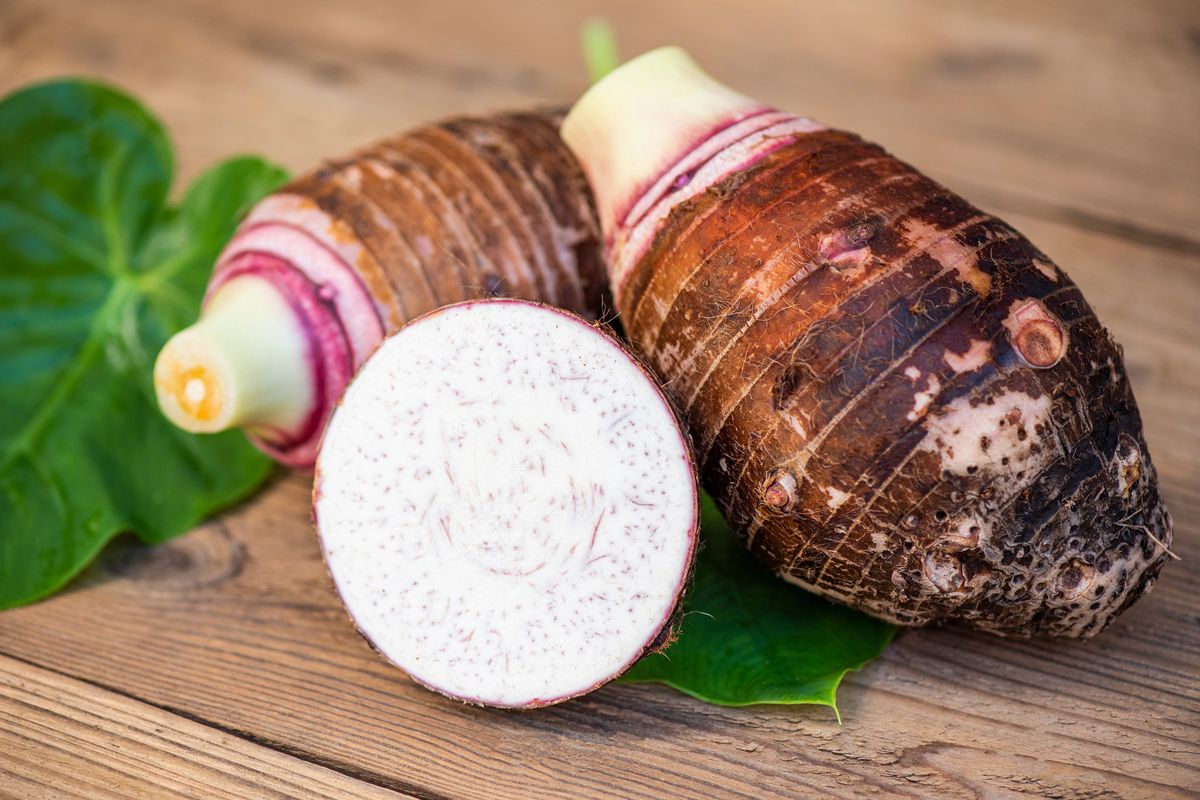Welcome to the Wonderful World of Taro!
Hey there, super parents! Are you on the lookout for a superhero tuber that can not only tickle your family’s taste buds but also pack a punch of nutrition? Look no more, because taro is here to save the day!
Taro, also known as Colocasia esculenta, is a root vegetable that’s been adding pizzazz to plates around the world for thousands of years. With its unique, nutty flavor and a texture that’s a cross between a potato and a sweet potato, taro is more than just a staple—it’s a superfood! And we’re here to tell you all about it.
Why Taro Deserves a Spot in Your Pantry
- Nutritional Powerhouse: Taro roots are a great source of dietary fiber, vitamins (such as Vitamin E and Vitamin C), minerals, and complex carbohydrates – a perfect combo to keep your little ones energized!
- Gluten-Free Goodness: For families mindful of gluten, taro is a fantastic alternative to traditional wheat-based products.
- Diverse and Delicious: One of the best things about taro is its versatility. You can boil it, bake it, fry it, or even turn it into a sweet treat. Talk about a culinary chameleon!
A Deep Dive into Taro’s Nutritional Benefits
Let’s take a moment to appreciate the nutritional value that taro brings to your family table:
- Rich in Fiber: Taro’s high fiber content can help maintain bowel health, lower cholesterol levels, and control blood sugar levels – keeping everyone’s tummy happy and healthy.
- Loaded with Vitamins & Minerals: Packed with vitamin C, vitamin E, vitamin B6, magnesium, iron, and more, taro supports immune function, skin health, and overall wellbeing.
- Low Glycemic Index: Taro’s low on the glycemic index, which means it’s a great option for steady energy release throughout the day, helping your kids stay focused during school and play.
Fun Facts to Share at the Dinner Table
While munching on delicious taro dishes, why not dish out some amazing facts that’ll make mealtime both educational and fun?
- Did you know that taro has been a staple food in many cultures for over 3,000 years? It’s a root with rich history!
- Taro leaves are also edible and are often used in dishes like the Hawaiian favorite, laulau. But remember, they have to be cooked first to break down the calcium oxalate that can be irritating if consumed raw.
- Taro is known by many names around the world, from ‘kalo’ in Hawaii to ‘arbi’ in India. It’s a globe-trotting tuber!
- In many Pacific Island cultures, taro is more than just food; it’s a symbol of life and is deeply embedded in their traditions.
How to Choose and Store Taro
Now that you’re all geared up to include taro in your family’s meals, choosing the perfect taro is key:
- Look for firm, blemish-free taro roots with a hairy texture.
- Avoid roots that feel soft or spongy, or have any signs of mold.
- To store, keep taro in a cool, dark place. Avoid refrigeration as it can change the root’s flavor and texture.
- When ready to use, wash it thoroughly and remove the skin, which can sometimes be a tad tough.
Also, a friendly note for the kitchen warriors: when peeling or cutting taro, either wear gloves or oil your hands, as the raw taro can sometimes cause skin irritation due to its calcium oxalate content. Safety first!
There we have it, dear parents – your introductory guide to the delights of taro. Not only does this little root veggie have a whole host of nutri-benefits for your family, but it’s also super versatile and delicious. In the next section, we’ll delve deeper into scrumptious recipes, allergy advice, and how to make taro a regular guest at your family feasts!
Stay tuned, because we’re just getting started on our tasty taro adventure. Your kids are going to be taro-fans before you know it!

Five Things Parents Should Know When Preparing Taro
Before you rush into the kitchen to whip up a taro-infused feast, there are a few important things to keep in mind:
- Peeling Perfection: While peeling taro, you may notice it’s a bit slippery. To ensure safety and ease, it’s best to cut the root into manageable pieces and use a sturdy peeler. Remember to keep a tight grip and peel away from your body.
- Combatting Irritants: Taro contains calcium oxalate crystals which can irritate skin and throat. To prevent this, always cook taro thoroughly and handle raw taro with care – wearing gloves is a smart move!
- Nutrient Retention: To maintain the robust nutrient profile of taro, opt for steaming or baking rather than boiling. This helps retain vitamins and minerals which can be lost in the boiling water.
- Allergy Awareness: If your family is new to taro, keep an eye out for any allergic reactions. While rare, allergies to taro do exist, and symptoms could include itching or stomach discomfort.
- Creative Cooking: Engaging your kids in taro meal preparation can be a fun and educational experience. Invite them to help with age-appropriate tasks like mashing cooked taro or mixing ingredients for taro pancakes. It’s a great way to spark their interest in healthy eating!
Innovative Taro Recipes for the Family
Cooking with taro can be a joyful journey of culinary discovery. From traditional taro balls in sweet ginger syrup to modern spins on fries and chips, here’s how you can bring a touch of taro magic to your dining table:
- Taro Fries: Swap out potato fries for a taro twist. Simply slice taro into sticks, toss with olive oil and your favorite herbs, and bake until crispy.
- Sweet Taro Pudding: Introduce a dessert that’s both sweet and wholesome. Mix pureed taro with coconut milk and a dash of sweetener, then chill for a delightful pudding.
- Taro Pancakes: For a fun breakfast, mix mashed taro into your pancake batter for extra fluffiness – a surefire hit with the kids!
By exploring these recipes and many more, you can delight your family with inventive and nutritious meals that celebrate the diversity of taro.
The Cultural Significance of Taro
Taro isn’t just a food item; it’s a cultural icon in many parts of the world. From the symbolic significance in Polynesian culture to its role in Asian festivals, understanding the background of taro can enrich your family’s experience of eating this venerable veggie.
- In Hawaii, the annual ‘Taro Festival’ celebrates the plant with hula performances, music, and lots of delicious taro dishes.
- In Asia, particularly China, taro is used to make mooncakes for the Mid-Autumn Festival, symbolizing family reunion and happiness.
- Many African countries rely on taro as a staple crop, often utilizing both the root and the leaves in traditional cooking.
Embracing taro can thus be a delicious opportunity to teach your children about the wide world out there, filled with traditions, stories, and flavors!
So, let’s peel, steam, and chop our way to health and happiness with taro – a journey that’s as rewarding as it is tasty. Get those pots ready, fire up the oven, and let’s make every meal count with a touch of taro love. Your family’s culinary adventure awaits!
For more great articles please see here. For more information see here
Disclaimer
The articles available via our website provide general information only and we strongly urge readers to exercise caution and conduct their own thorough research and fact-checking. The information presented should not be taken as absolute truth, and, to the maximum extent permitted by law, we will not be held liable for any inaccuracies or errors in the content. It is essential for individuals to independently verify and validate the information before making any decisions or taking any actions based on the articles.




